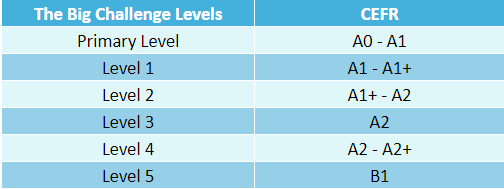Register your students to The Big Challenge experience!
Benelux
The Assessment
The quiz questions are divided into 3 levels of difficulty: easy, intermediate and difficult questions.
There’s a different number of questions in of each difficulty. The number of points awarded for a question in the different levels are different as well.
All corrections are made by The Big Challenge.
For each of the school levels from primary to secondary, three rankings will be established: national, regional and by school.
| Contest | ||||||||||||||||||||
| Number of questions | 55 questions | |||||||||||||||||||
| Points per correct answer |
|
|||||||||||||||||||
| Points for incorrect answer |
|
|||||||||||||||||||
| Points in absence of response | If no answer is given, the question is scored 0 points. If more than one answer is given, the question is also scored 0 points. | |||||||||||||||||||
| Bonus points | To avoid the risk of obtaining a negative number of points or 0 points, the total number of points obtained by adding all the points is increased by 85 points. Thus, each student’s grade will be between 18.75 and 350 points. | |||||||||||||||||||
| Example |
11,25 + 85 = 96,25 points For this example, the final score would be 96.25 out of 350. |
|||||||||||||||||||
Frequently asked questions
Between primary and secondary there are 6 levels of questionnaires corresponding to each school level. The questionnaires are based on the CEFR.
You will find our recommendations below:

If you have any questions regarding the levels, please do not hesitate to contact us and we will be happy to inform you.
If the student is able to eliminate one or two "wrong answers" and then hesitates between the remaining two, they should answer at random. Otherwise, it's better not to answer.
If you apply this method throughout the questionnaire, they're bound to succeed. A student who fills in an entire grid at random will have a final mark close to zero with our marking system. With a one in four chance of getting it right (and therefore scoring 4 points for an easy question) and losing a quarter of that score (1 point) every time they get an answer wrong, they will statistically arrive at a total close to zero.
On the other hand, a student who is not sure which of the four possible answers is right, but who is able to eliminate two wrong answers by thinking, for example, will be favoured because he will have a 50/50 chance of getting it right and will still only lose one point if he is wrong. But it's only because they've thought through the different possibilities first that they'll have a better chance.
And ultimately that's what we want: for students to learn to think before they answer!
Register your students to The Big Challenge experience!